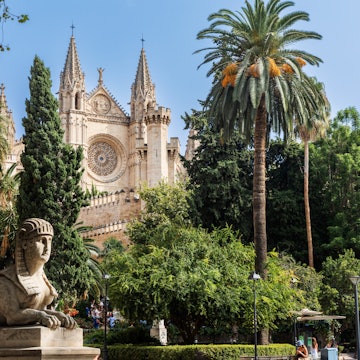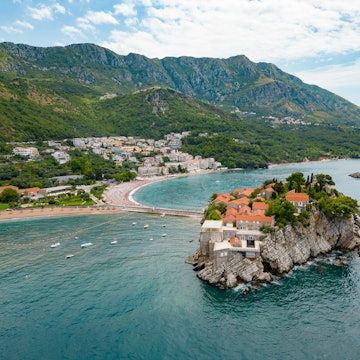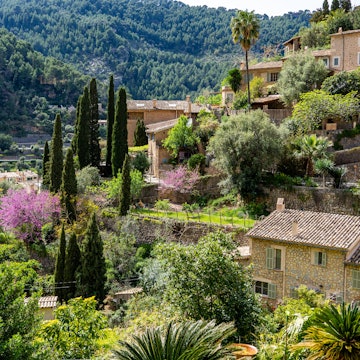

The hilltop village of Deià, Mallorca. Tain Nattapong/Shutterstock
Balearic Island queen Mallorca is so much more than the sum of its reputation as a fly-and-flop beach destination in the Mediterranean. This Spanish island has real magic up its sleeves. The capital, Palma, has a booming food scene, backstreet patios and a Gothic goliath of a cathedral. Long-distance hiking trails pick their way over the Serra de Tramuntana’s wind-scoured limestone peaks. And there are honey-stone hilltowns that could rival any in Europe for beauty, and coastal-road trips that send heart rates and souls soaring. Art by Picasso and Miró, Chopin piano recitals, pilgrimage trails to lonely monasteries in the quiet hinterland – you’ll find the lot here.
Here are our favorite things to do on the island to get you started, but stray away from the crowds (and you really should) and you’re bound to find your own faves.
1. Explore Cap de Formentor
Mallorca ramps up the coastal drama where it slings its northern hook into the brilliant blue Med. Here knife-edge cliffs and the wind-scarred limestone peaks of the Serra de Tramuntana rear up like waves on the point of breaking. Every snaking bend along the Cap de Formentor peninsula will make you want to lunge for your camera. As will the beach at Platja de Formentor, a pine-flanked ribbon of pale sand shelving gently into crystal-clear water. Go for a dip or rent paddleboards or kayaks to explore.
Local tip: Arrive by boat from Port de Pollença or by car on the helter-skelter road along Cap de Formentor, stopping at viewpoints like the Mirador del Mas Pas. The lighthouse topping the headland delivers peachy sunsets.

2. Flop on east coast beaches
Eastern Mallorca has some of the island’s prettiest and least-developed playas. The bays and crescent-shaped coves near Cala Ratjada entice with soft, creamy sands and startlingly turquoise waters framed by pine-flanked cliffs and sand dunes. Loveliest of the lot are Cala Mesquida, Cala Mitjana and Cala Matzoc, particularly if you arrive early in the day and avoid the peak season rush.
Local tip: Bring plenty of water and a picnic onto the circular 10km walking trail from Cala Agula (near Cala Ratjada), which leads through the pines of a nature reserve to dune-flanked Cala Mesquida. En route, look out for Talaia de Son JaumeII, a 16th-century watchtower built to ward off pirate attacks.
3. Ride the rails on Ferrocarril de Sóller
Bringing you back to a bygone era, the vintage, wood-paneled Ferrocarril de Sóller from Palma to Sóller has been rattling along the mountain tracks since 1912. The hour-long journey is one you’ll want to write home about. It delivers a wonderful hit of rural, pre-dawn-of-tourism Mallorca as the train chugs past lemon and orange orchards, farms, fields and carob, olive and almond groves, ravines and lost-in-time villages like Bunyola before emerging into the foothills of the towering Serra de Tramuntana.
Planning tip: From April to October, trains run from Palma to Sóller six times a day. There is a reduced service in November, December, February and March, with four trains per day in each direction. Buy tickets ahead in peak season.


4. Find the poetic dream in Deià
Mallorca isn’t short on the kind of villages that get tons of Instagram likes. But lovely Deià on the island’s northwest coast has the edge, with honey-colored, terracotta-tiled, bougainvillea-draped houses pasted to a steep hillside. Clasped between the bright-blue Med and the lushly wooded peaks of the Serra de Tramuntana, this aerie-like village sits among orchards, almond and olive groves, vegetable gardens and vineyards like a modern-day Eden.
Deià’s beauty has long been feted by artistic souls, not least British poet Robert Graves, who adored it so much, he built his dream house here in 1929 with his partner, American poet Laura Riding. Now you can visit La Casa de Robert Graves before reading or writing some poetry of your own on the mountain-facing Poets’ Walk at Belmond La Residencia.
Detour: Tack on a visit to Son Marroig, a lavish mansion that once belonged to Habsburg Archduke Ludwig Salvator, with romantic views out to sea from the gardens. Here you can ask for permission to walk the 3km path through olive grove and pine down to Sa Foradada, a bizarre hole in the rock that resembles an elephant from certain angles.
5. Hike the Ruta de Pedra en Sec
Wild, jagged and scarred by elemental forces over millennia, the dramatically sculpted limestone peaks of Mallorca’s UNESCO World Heritage-listed Serra de Tramuntana run like a knobbly backbone across the island’s north. The range is a hiker’s dream, with summits, crags and ravines that can only be explored on foot. There are many day treks to give you a taste, including a challenging 13km stomp from Valldemossa that ticks off a 1064m ascent of Puig del Teix, with broad views over mountain and sea.
For a deeper dive, go for the big one: the long-distance Ruta de Pedra en Sec, or GR221, which stretches 140km from Port d’Andratx to Port de Pollença, and takes the entire Serra de Tramuntana in its stride. Walking on well-signposted medieval cobbled paths hemmed by drystone walls, you’ll often find yourself alone in silent olive groves, atop crags where nimble-footed Mallorcan goats leap and at lookouts revealing fiery sunsets out at sea.
Local tip: Though not technically difficult, the Ruta de Pedra en Sec hike is moderately challenging, crossing steep, rugged terrain. Tackle the trail in the cooler months as the summer heat can be intense. There are village B&Bs, refugis (simple mountain lodges) and hilltop monasteries where you can stay overnight. The Cicerone guide is a handy companion.

6. Marvel at Catedral de Mallorca in Palma
Rising up above the sea in a riot of golden stone, soaring pinnacles and flying buttresses, Palma’s great Gothic cathedral is unmissable – in every possible sense of the word. Built upon the ruins of a Muslim mosque in 1300, the cathedral’s interior is a temple of light, with pillars rising to support a great ribbed vault. Look out for the striking crown-of-thorns canopy over the altar, bearing the hallmark of Antoni Gaudí, and Miquel Barcelo's Chapel of the Holy Sacrament, a ceramic wonder telling the miracle of the loaves and fishes.
Arrive at the cathedral early to see the morning light stream through the rose window, which is Europe’s largest, and rainbow light patterns dance across the vaulted interior. Climb up to the roof terraces for a closer look.
Detour: Right next door – and just as special – is the Palau de l'Almudaina, originally an Islamic alcázar (Muslim-era fortress), converted into a royal residence in the late 13th century, and now the king of Spain’s plush summer digs. The cathedral is also a terrific starting point for nudging deeper into the Sa Calatrava quarter of Palma, once the heart of the old medina.
7. Stay in a monastery
Forget the coast: heading off piste and striking out on foot into Mallorca’s rugged, mountainous interior is how you’ll really touch the island’s soul. And there’s no better way to immerse yourself nature and find a proper slice of away-from-it-all Mallorcan life than by bedding down in one of the island’s old monasteries or hermitages, where it’s so quiet you can hear an olive plop or distant goat bells tinkle.
There are many monasteries scattered all over the island, but our favorites include hilltop Santuari de la Mare de Déu des Puig, a former medieval nunnery reached by a stiff, hour-long hike through holm oak, pine and olive from Pollença; pilgrims’ refuge Monestir de Lluc, high in the Tramuntana; and Ermita de La Victòria, a crisply converted 14th-century hermitage on a peninsula near Alcúdia, with glorious coastal trails on its doorstep.
Local tip: Advance booking is always a good idea, especially in high season (May to September).


8. Dig into a Mallorcan feast in Palma
Palma de Mallorca is now on the map as one of the most exciting places for food in the Med. But where to begin? For island produce and a hit of market life, graze your way around Mercat de l’Olivar, where stalls heave with cheese, fish, meat, fruit and veg, plump olives and wafer-thin jamón serrano. You’ll also find tapas and freshly shucked oysters to nibble on.
Emphasizing ingredients from the sea, mountains, meadows, farms and orchards, the city’s chefs are turning out menus with newfound flair and creativity, some reaching for Michelin-star status. In a former 17th-century convent, Marc Fosh is the table to book well ahead, putting imaginative riffs on clean, bright Balearic flavors. Equally superb is Adrián Quetglas, with dishes that sing with island produce, such as turbot with peas, Tramuntana lemon and lemon verbena. For elevated tapas in a grown-up, monochrome space, swing over to La Bodeguilla, run by two brothers. Meltingly tender suckling pig is the star of the produce-led menu.
Local tip: Don’t leave without biting into an ensaïmada (a flaky, feather-light, snail-shaped pastry dusted with icing sugar). Old-school Ca'n Joan de S'Aigo and Forn del Santo Cristo bake the best.
9. See Picasso and Miró in Sóller
Cradled by citrus orchards and the Serra de Tramuntana’s towering limestone peaks, the ochre-stone town of Sóller in Mallorca’s northwest would win on looks alone, but you come here for culture. The town’s historic center is a beauty, with alleys lined with grand merchants’ houses leading to plazas like cafe-rimmed Plaça de la Constitució. You’ll be drawn to the Església de Sant Bartomeu, a striking baroque church that was given a modernist makeover by Joan Rubió, a protégé of Antoni Gaudí.
Sóller’s art stash could rival that of many major cities, with top billing going to Ca'n Prunera, showing works by Joan Miró, Picasso, Gauguin, Toulouse-Lautrec and Klimt in a modernist mansion. More surprising, however, is Sala Picasso & Sala Miró at Sóller’s train station, where you can marvel at bold Picasso ceramics swirling with women and bullfighters, and eye-catching prints by Catalan master Miró – all for free.
Local tip: Sóller’s charms haven’t gone unnoticed and the town heaves in peak summer. Go in spring or autumn for a more low-key visit.

10. Drive the helter-skelter road to Sa Calobra
You might want to say a quick prayer before turning off the MA-10 – the road that whips through the heights in Mallorca’s north – and swerving onto the MA-2141 down to Sa Calobra. This hair-raising, heart-pumping, knuckle-whitening, brake-screeching 12km road is a beauty, but its looping hairpin bends are only for fearless drivers.
The road is the tour de force of Italian engineer Antonio Paretti, who built it in 1932. Translating as "the snake," it twists and turns just like one, skirting narrow ridges and getting perilously close to the edge as it dips down to a ravine that carves through the wild, ragged peaks of the Tramuntana to the cold, deep, sapphire blue sea. Think driving it is tough? Try scaling it by mountain bike like Tour de France winner Bradley Wiggins who, for the record, pedaled up in just 26 minutes.
Local tip: Sa Calobra’s beach gets insanely crowded in high summer. Come early or late in the day, or go one beach over for slightly more peace to Cala Tuent, a turquoise cove in the shadow of Puig Major.
11. Tune into Chopin in Valldemossa
With arresting views of the wooded slopes of the Tramuntana and terraced hillsides, the honey-stone, alley-woven, flower-strewn village of Valldemossa is ludicrously pretty. But here good looks also equate to popularity, so whatever you do arrive bright and early before the daytrippers, preferably in low season.
The romance of Valldemossa is all wrapped up in the Real Cartuja, a grand Carthusian monastery that has been home to kings, monks and 19th-century stars: composer and legendary pianist Frédéric Chopin and his partner, the French novelist George Sand. The pair spent the winter of 1838 here. Entry includes hourly piano recitals.
Local tip: Time your visit to catch the Pianino Festival, which kicks off in March and runs through summer, where classical music performances of Chopin’s works (some on his original piano) are held in Valldemossa's Real Cartuja.

12. Climb Pollença’s Calvari
Caught between the mountains of the Serra de Tramuntana and the sea in the island’s north, Pollença is never lovelier than in the glow of late afternoon, when you duck into narrow alleyways full of beauty and banter, or pull up a chair on one of the cafe terraces rimming the Plaça Major and watch kids play in the shadow of Gothic-baroque Església de la Mare de Déu dels Àngels.
As the heat of the day subsides, it’s also the time to climb the Calvari (Calvary), founded by the Knights Templar in the 12th century to protect Christians who made the pilgrimage to Jerusalem after its conquest. Take a breath then climb the 365 steps to the tiny chapel at the top, past cypress trees and stone crosses. At the top, far-reaching views over the town’s rooftops to the mountains beyond unfold.
















